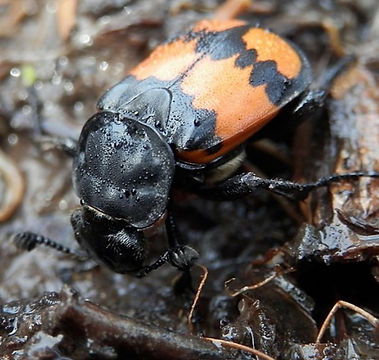These people do great research, and I have been fortunate enough to work with them over the years.
These people do great research, and I have been fortunate enough to work with them over the years.
BETHANY ROBERTON
Biotic environments and their influence
I am interested in how biotic interactions shape individual traits. By looking at (i) the plastic response of individuals, (ii) the ability of biotic environments (social and otherwise) to induce such plasticity(iii) underlying genetic variation in biotic environments, I explore the evolutionary consequences that such trait variation may have on populations, from the maintenance of genetic variation to its potential to initiate divergence. I have used various insect species to tease apart such interactions:

Nicrophorus spp.
burying beetles
It’s all in the family. And nothing could be more true for burying beetles. Parents perform elaborate parental care, from finding and preparing a small dead vertebrate carcass for their offspring to feeding and protecting them as they develop in and consume the carcass. In other words, parents create the environment in which offspring develop, and interactions between parents and offspring can influence the phenotypes of those offspring. Parents may thus facilitate evolutionary change through their choice and preparation of a suitable carcass host, and the subsequent interactions with their offspring on that carcass. This work is being done in collaboration with Rebecca Kilner and Ana Duarte.
ephippiger diurnus bushcrickets
Chorusing bushcrickets create a dynamic social environment. Males advertise for females by producing calls in a regularly repeated rhythm. Calls contain syllables, and the average number of syllables per call varies among the various geographically isolated populations of E. diurnus. With Michael Greenfield and Flavia Barbosa, we have been studying how individuals are influenced by the acoustic environment created by chorusing males. Specifically, we address whether variation in call syllable number, a strong determinant of female mate preference, influences male and female pre- and post-copulatory reproductive investment.

ENCHENOPA BINOTATA TREEHOPPERS
You, tree, and me make me me. Each member of this species complex lives on its own host plant species. Individuals hatch and develop on a single plant until adulthood, upon which they search for mates and pair formation occurs via vibrational male-female signal duets. By manipulating the developmental environment, my collaborator Rafa Rodríguez and I have shown that genetic variation in both the host plant and in the social neighbors on the plant during development influence the adult phenotype of individuals in those environments. We have also shown that experience of other male and female signals during adulthood influence two different aspects of male signaling behavior. In other words, you (your neighbors), tree (the host plant), and me (your genotype), all contribute to your adult phenotype.
Teleogryllus oceanicus field crickets
Males produce two distinct songs in the context of mating: a calling song to attract females from a distance and a courtship song once a female has arrived. Females have complete control over mating – they can decide to mate or not mate with a male, and they remove the spermatophore that males give them during mating. As courtship songs immediately precede mating, females may use the features of this song to influence their pre- and post-copulatory mating behaviors. In collaboration with Marlene Zuk and Nathan Bailey, we found that female choice operates in parallel: females mate faster with males that have more attractive courtship songs and they retain those spermatophores longer.



